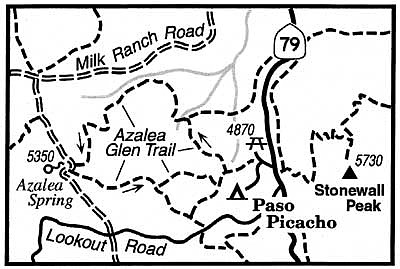 Facebook
Facebook
 X
X
 Instagram
Instagram
 TikTok
TikTok
 Youtube
Youtube
Prior to October 2003's great Cedar Fire, Cuyamaca Rancho State Park sprawled across more than 25,000 acres of chaparral, gentle meadows, gurgling streams, and forests of pines, firs, cedars, sycamores, and oaks. Today, of course, that same acreage consists of a vast "ghost forest" of blackened trunks. Nearly all of the park's coniferous (cone-bearing) trees were fatally burned, though many other tree species more adaptable to wildfire -- oaks, sycamores, and alders -- are showing signs of renewed vitality.
The Azalea Glen loop trail, perhaps the coolest and most shady pre-fire trail route in the park, has recently been reopened for hiking. Summer's heat isn't fully upon us yet, so now is a good time to explore the recovering landscape that is showing strong signs of rebirth after a remarkable rainfall season.
You begin at Paso Picacho campground/picnic area, located at the high point along Highway 79, 10 miles south of Julian and 12 miles north of Interstate 8 at Descanso. The trail begins across from the picnic area, not far from the restrooms at the entrance. First follow the trail 0.2 mile west to a split. Take the right fork in order to hike the trail counterclockwise, as described here.
Contour through a landscape of blackened trunks and tender new growth at ground level, crossing three small ravines. At 0.6 mile from the split, you arrive at a bracken-fern-fringed meadow. Don't miss the small collection of morteros (Indian grinding holes) on the nearby granite slabs. On the far side of the meadow, you plunge into the blackened forest again, and descend to the bank of a small brook, informally called Azalea Creek. Here, fledgling western azalea, thimbleberry, and other moisture-loving plants are attempting a comeback. Western azaleas typically bloom with aromatic white flowers in May or June.
Next, the Azalea Glen Trail turns steeply uphill. You proceed a sweaty one-half mile along a narrow, rocky stretch to the trail's top end, where you come upon the relatively wide Azalea Spring Fire Road in a clearing. Azalea Spring, along with a covered cistern undamaged by the fire, is nearby, serving as a popular resting place and water stop for hikers and horses.
From Azalea Spring, it's back into the forest again as you descend moderately on a wider leg of the Azalea Glen Trail, signed "Azalea Glen Fire Road." Let gravity repay its debt to you, and keep your eyes and ears open for birds and wildlife, which are scarce but increasing in abundance as the landscape renews itself.


Prior to October 2003's great Cedar Fire, Cuyamaca Rancho State Park sprawled across more than 25,000 acres of chaparral, gentle meadows, gurgling streams, and forests of pines, firs, cedars, sycamores, and oaks. Today, of course, that same acreage consists of a vast "ghost forest" of blackened trunks. Nearly all of the park's coniferous (cone-bearing) trees were fatally burned, though many other tree species more adaptable to wildfire -- oaks, sycamores, and alders -- are showing signs of renewed vitality.
The Azalea Glen loop trail, perhaps the coolest and most shady pre-fire trail route in the park, has recently been reopened for hiking. Summer's heat isn't fully upon us yet, so now is a good time to explore the recovering landscape that is showing strong signs of rebirth after a remarkable rainfall season.
You begin at Paso Picacho campground/picnic area, located at the high point along Highway 79, 10 miles south of Julian and 12 miles north of Interstate 8 at Descanso. The trail begins across from the picnic area, not far from the restrooms at the entrance. First follow the trail 0.2 mile west to a split. Take the right fork in order to hike the trail counterclockwise, as described here.
Contour through a landscape of blackened trunks and tender new growth at ground level, crossing three small ravines. At 0.6 mile from the split, you arrive at a bracken-fern-fringed meadow. Don't miss the small collection of morteros (Indian grinding holes) on the nearby granite slabs. On the far side of the meadow, you plunge into the blackened forest again, and descend to the bank of a small brook, informally called Azalea Creek. Here, fledgling western azalea, thimbleberry, and other moisture-loving plants are attempting a comeback. Western azaleas typically bloom with aromatic white flowers in May or June.
Next, the Azalea Glen Trail turns steeply uphill. You proceed a sweaty one-half mile along a narrow, rocky stretch to the trail's top end, where you come upon the relatively wide Azalea Spring Fire Road in a clearing. Azalea Spring, along with a covered cistern undamaged by the fire, is nearby, serving as a popular resting place and water stop for hikers and horses.
From Azalea Spring, it's back into the forest again as you descend moderately on a wider leg of the Azalea Glen Trail, signed "Azalea Glen Fire Road." Let gravity repay its debt to you, and keep your eyes and ears open for birds and wildlife, which are scarce but increasing in abundance as the landscape renews itself.
